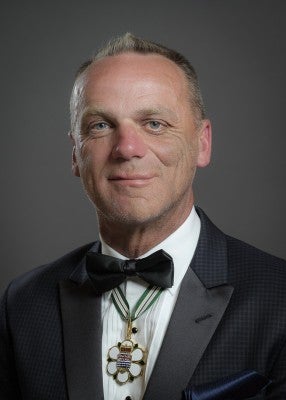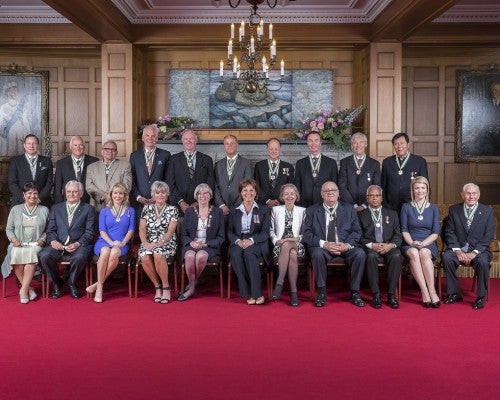
V-Chip technology put viewers in control of TV content
The rise of Netflix, YouTube and other online streaming services makes it seem nearly impossible to avoid possibly objectionable video content

The rise of Netflix, YouTube and other online streaming services makes it seem nearly impossible to avoid possibly objectionable video content
By Shane Schick Faculty of Engineering The rise of Netflix, YouTube and other online streaming services makes it seem nearly impossible to avoid possibly objectionable video content, but without Tim Collings, a Waterloo Engineering, electrical engineering graduate, the situation on traditional TV sets might have been even worse.
The rise of Netflix, YouTube and other online streaming services makes it seem nearly impossible to avoid possibly objectionable video content, but without Tim Collings, a Waterloo Engineering, electrical engineering graduate, the situation on traditional TV sets might have been even worse.
Collings was recently appointed to the Order of British Columbia for his work in developing the V-chip technology, which allows consumers to block content that might not be appropriate for certain viewers such as children. After being deeply affected by the 1989 massacre of 14 women at Montreal’s École Polytechnique, Collings decided to use the skills developed while a student of Waterloo Engineering to help ensure content on television didn’t reach the wrong audience. At a time when TV was one of the only communications mediums of its kind to transmit broadcast images, its place in the public consciousness was a powerful and potentially dangerous one.
“In the aftermath of all these horrendous tragedies we always ask why,” he says. “It just seemed to me that the things we watch have such a profound impact on how we act. I just felt that this was really something where technology could have a hand in helping those who wanted to get a bit more control around what was coming into their homes.”

The 2015 Order of British Columbia Investiture Ceremony for recipients and invited guests took place on Monday, June 15, 2015 at Government House
Collings started work on the V-Chip technology in 1989 and by 1993, despite some resistance from broadcasters, it was championed by the U.S. and Canadian governments, among others, as a way to keep violent programming at bay. The V-chip technology blocks out programs based on predetermined ratings for violence, sex and language. In that sense, it actually predates some of the sophisticated ways multimedia content is organized and classified today.
“If you look at how content is meta-tagged and labelled these days, it was one of the first times that you really got this incredibly rich meta-information with the program to describe what it was about,” Collings says.
Though he later transitioned from engineering student to teacher at Simon Fraser University, Collings credits the University of Waterloo unique engineering education for giving him both the skills and connections to help him pursue his dream.
“The great thing about Waterloo was great teaching, and we were working in some great research labs,” he says. “The link to industry was really fundamental. Any engineering graduate will tell you that their co-op work terms gave them a real sense of what was possible.”
Collings recommends that engineers of the future build upon connections between academia and business, created during co-op, as they pursue breakthrough ideas like the V-chip.
“The barriers to entry seem to be lower now. You don’t need a big research lab to create a groundbreaking app,” he points out. “Take advantage of the opportunity you have to connect with people. Not just engineers but business people. If you’re interested in creating something for the health-care sector, be talking to doctors, asking them questions about biomedicine. Go to trade shows outside of engineering. Get involved as early and as often as you can.”
For more stories from the Electrical Engineering Community, check out EEWeb.

Engineering master's student Nayeema Nonta (left), one of the three paper authors, and her supervisor, Dr. Sirisha Rambhatla, in a large server room with the computer power needed to develop their new LLM training technique. (University of Waterloo)
Read more
Waterloo researchers develop highly efficient AI training system that paves the way for cheaper, greener “intelligent partners”

Read more
Engineering researchers team up to tackle the plastics pollution problem with microbial innovation and engineering design

Read more
15 University of Waterloo researchers have been named to the annual Highly Cited Researchers™ list for significant contributions to their specific fields of research
Read
Engineering stories
Visit
Waterloo Engineering home
Contact
Waterloo Engineering
The University of Waterloo acknowledges that much of our work takes place on the traditional territory of the Neutral, Anishinaabeg, and Haudenosaunee peoples. Our main campus is situated on the Haldimand Tract, the land granted to the Six Nations that includes six miles on each side of the Grand River. Our active work toward reconciliation takes place across our campuses through research, learning, teaching, and community building, and is co-ordinated within the Office of Indigenous Relations.